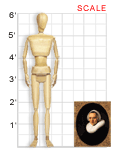VAM galleries including this work:
The Speed Art Museum | Go Figure | Art Through Time || VAM Home
Rembrandt Harmensz Van Rijn (Dutch, 1606-1669)
PORTRAIT OF A WOMAN, 1634
Oil on panel; 25-1/2" X 32"
Purchased with funds contributed by individuals, corporations, and the entire community of Louisville, as well as the Commonwealth of Kentucky 1977.16
The Speed Art Museum
One of the most famous Dutch artists of the 17th century, Rembrandt was known for his incredible skill as a portrait painter, and this portrait of an unknown woman is one of the most admired works in the collection of the Speed Art Museum. Although we do not know the sitter’s name or who she was, a close examination of the portrait tells us much about her. The inscription at the left says she was 40 years old when the portrait was painted, and her clothing indicates that she was a member of the prosperous middle class. She is soberly dressed, in keeping with the Calvinist religious beliefs prevalent in Holland at the time. Calvinism encouraged an outwardly conservative bearing and frowned on showing off wealth or social position.
More subtly, Rembrandt creates a portrait that goes beyond mere physical likeness. Although the sitter is not a conventionally beautiful woman, her portrait is transfixing because of the way Rembrandt has illuminated her face. The companion portrait to this painting, Portrait of a Bearded Man in a Wide-Brimmed Hat, 1633, depicts this woman’s husband. Since the two portraits were painted as a pair and meant to hang together, the interior lighting in both portraits comes from the left, and the figures turn slightly toward each other.
The two portraits remained together until 1960, when they were sold separately at auction in New York City. In 1977, the woman’s portrait was purchased by the Speed Art Museum, while the Norton Simon Art Foundation purchased the husband’s portrait.
These two portraits are the earliest known husband-and-wife pair by Rembrandt. Although the identities of the woman and her husband still elude us, the high quality and essential dignity of their portraits indicate that Rembrandt clearly empathized with his subjects.
About the Artist
Rembrandt van Rijn was born in the Netherlands in 1606. Although his family had little money, his parents recognized the value of a good education, and Rembrandt was sent to Latin school and then to the University of Leiden. But while his parents desired a professional career for their son, Rembrandt’s true interest was art, and he left the university shortly after enrolling to study with a local master. After completing his training, he moved to Amsterdam to study with artist Pieter Lastman. He mastered his lessons in six months and then returned to Leiden to begin training students of his own.
Rembrandt enjoyed great success for many years, until his taste for a lavish lifestyle drove the artist to near bankruptcy and personal losses began to affect his emotional stability. In addition, the artistic tastes of the popular audience had shifted considerably toward the end of his career. Rembrandt’s refusal to conform to the new style ultimately lost him the favor of his contemporaries.
A prolific artist, he produced approximately 600 paintings and 1,400 drawings as well as the 300 etchings. A master of light and shadow, Rembrandt painted landscapes, portraits, self-portraits, and religious subjects. His portraits demonstrate a keen ability to penetrate to his subject’s character, and his landscapes provide a vivid record of 17th-century Dutch life.
Classroom Ideas
Discussion: Examine school portraits of students or a formal contemporary photographic portrait. Compare the contemporary portraits with this painting. Discuss how portraits have changed or remained the same in the more than 300 years since Rembrandt painted the portrait.
What does this portrait tell you about the woman—both her physical appearance and her personality? How does the artist use the elements of art and principles of design to convey these characteristics?
Look at other portraits in the Kentucky Virtual Art Museum and at photographic portraits from current magazines. How do they compare with the Rembrandt portrait? Are some more formal and “posed” than others? What sort of effect does the formality or informality of a portrait have on the way we experience it? What do we learn from details such as clothing and backgrounds?
Activity: Create a portrait of a relative or friend designed to convey both personality and physical characteristics.
Links
Visit these museums for more information about Rembrandt as well as images of his work:
- National Gallery of Art (which has 93 images of his work online)
[www.nga.gov/cgi-bin/pbio?26200] - Art Institute of Chicago (19 images online)
[www.artic.edu/aic/exhibitions/rembrandt.html] - Getty Museum (16 images online)
[www.getty.edu/art/collections/bio/a473-1.html]
You’ll find some ideas for exploring portraits at the Speed Art Museum.
[www.speedmuseum.org/educational_poster.html]


